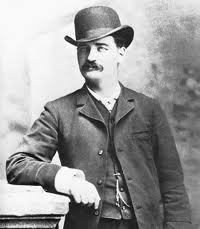Fame in Familiar Flavors
Bat Masterson used to be famous. A gunfighter, lawman, buffalo hunter, pugilist, gambler, boxing promoter, and newspaper columnist, Masterson was a man’s man from the Wild West who lived the latter half of his life on Broadway in New York City. He killed several men, was involved in countless brawls and lawsuits, and lived a life worthy of fiction. One of his younger New York friends, Damon Runyan, thought so – he created the character “Sky Masterson” thinking of Bat. Sky would later achieve a different kind of fame as the lead in the musical Guys and Dolls. Theodore Roosevelt was equally enchanted. When President, Roosevelt arranged for a federal sinecure for Masterson.
Robert K. DeArment is probably the world’s expert on Bat Masterson. His latest work, Gunfighter in Gotham: Bat Masteron’s New York City Years, chronicles Masterson’s life but focuses on his time on the Great White Way. Masterson’s New York City was very much Runyon’s: a small district around Times Square filled with types. Masterson did have exploits, but were they worthy of our collective attention? His prose was nothing special; nor were his opinions, causes, or arguments. He was not a leader and he left no exceptional mark on his environs. He was a friend and a colleague to many and a dangerous enemy to a few.
Thinking of Bat Masterson brings to mind other celebrities famous for being famous, a category now enshrined in popular culture. We often think that the rise of the fake celebrity is a recent phenomena driven by the internet and social media. In reality, it is a part of modern life and has been for decades. We regularly think about, read about, and write about popular figures whose actual claim to fame is, at best, tenuous. Our fascination with fame is as much about us, the public, as it is about the object of our attention, the celebrity.
Those famous for being famous often share similar traits. They actively seek to maintain their celebrity. That kind of fame does not just happen – it requires ongoing work. And if you doubt me, consult with Kathy Griffin. Also, these kinds of celebrities tend to embody characteristics that are taken to an extreme. Masterson’s hyper-masculinity stands as a provocative counterpoint to the hyper-femininity of the Spice Girls or the Kardashians.
As for Masterson, DeArment’s volume provides more than I would ever care to know about the man in print. I will hold judgement about meeting Masterson in person – I think that he would have been a heck of an interesting fellow to meet at the bar.
David Potash